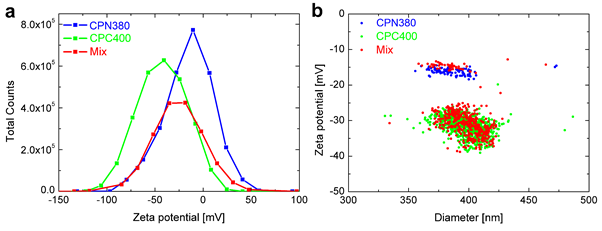Why measure zeta potential with TRPS instead of Zetasizer?
Whilst TRPS measures the zeta potential and size of single particles, phase analysis light scattering (PALS, Zetasizer) only measures the average zeta potential of a population/ensemble of particles. The figure below shows the comparison of a) phase analysis light scattering analysis and b) TRPS of bimodal charged samples in phosphate buffered saline. 
Analysis of the two samples of 380 nm low charged polystyrene particles and 400 nm highly charged carboxylated polystyrene particles (TRPS data points: blue for CPN380, green for CPC400; traces as labelled for PALS data) agree well between the two techniques.
However, there is a huge discrepancy between these techniques when the two particle types are mixed to give a bimodal sample. Whilst TRPS can resolve the two particle types (red data points) with zeta potentials agreeing well with values from unmixed samples, PALS can only measure a solution-averaged zeta potential value (red trace).